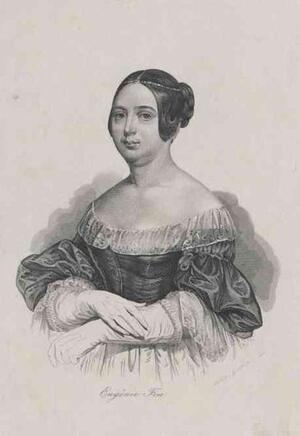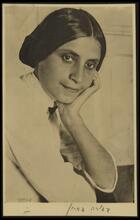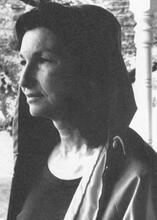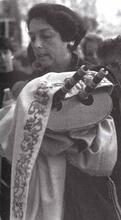Eugénie Foa
Eugénie Rodrigues-Henriques Foa (1796-1852), the first Jewish woman to make a living as a professional writer. Image courtesy of the Austrian National Library via Wikimedia Commons.
Eugénie Foa (1796-1852) was, to our knowledge, the first Jewish woman to support herself professionally as a literary writer. She was born in Bordeaux to a wealthy Sephardi family engaged in international trade, later moving with them to Paris after her brief unhappy marriage failed. Based in Paris, she wrote in French and was active in circles of French women writers who advocated for greater recognition. She broke with her family in 1841 and converted to Catholicism, after which she wrote a series on the lives of saints. She wrote novels and newspaper articles on a variety of topics, including stories about Jews, but also on fashion, literature, and historical figures of all sorts. She is best remembered for her children’s books.
The prolific author Eugénie Foa was born Rebecca Eugénie Rodrigues Henriquès in Bordeaux, France on June 12, 1796, and died in Paris in 1852. The first Jewish woman to support herself from her writings, Foa was best known for her children’s stories. She also wrote several novels and short stories in the Romantic genre of her day, some of which treated Jewish subjects. In addition, Foa contributed many articles to contemporary periodicals, sometimes under the pseudonym Miss Maria Fitz-Clarence. She was likely the founder of the Journal des enfans (Children’s Journal), the first periodical aimed explicitly at a young audience. Foa also became involved in the emerging feminist movement, contributing in 1848 to the feminist journal La Voix des femmes (Women’s Voice). She also helped establish the Institut des femmes, an academy of women writers. She was particularly concerned with the challenges that women writers faced at the time, their difficulties in finding financial support and public recognition. In her own day, Foa’s books were extremely popular, going through numerous printings. Several of her children’s stories were translated into English and she had a following in the United States as well as France.
Family
Foa was born into the elite class of French Sephardic Jewry, and like many others in their world, the family relocated from Bordeaux to Paris in the 1810s. Her parents hailed from two of the most important and wealthy Jewish families of Bordeaux. Her father, Isaac Rodrigues Henriquès, was head of a family bank called Les Fils d’A. Rodrigues; her mother, née Esther Gradis, was the daughter of David Gradis, an important community leader, philanthropist, and merchant whose business, David Gradis et fils, specialized in armaments and the colonial trade (especially in the West Indies and Canada).
Foa’s family left an important mark on nineteenth-century French culture. Her sister was Hanna Léonie Rodrigues Henriquès (1820-1884), a noted sculptor who married the composer Jacques-Fromenthal Halévy (1799-1862) in Paris in 1842; their daughter was the noted Dreyfusard salon hostess, Geneviève Halévy Bizet Strauss (1849-1926). Eugénie’s brother Hippolyte worked in the family bank, but also wrote numerous works of fiction as well as treatises on the place of Judaism in the modern world.
In 1814, Eugénie married the 21-year-old Geonoese merchant Joseph Foa, but the marriage was unhappy and short-lived. After her abusive husband left her, Eugénie moved back into her parents’ home on Paris’s rue Monthalon, where she lived until her father’s death in 1836. She struggled with Joseph over custody of their son, Edouard (b. 1820), who ran away from his father’s home in Liège in 1834 to find his mother, only to be arrested and condemned to a three-year incarceration for “vagabondage.” French law gave Eugénie few rights as a mother and abandoned wife; only the intervention of her uncle, Benjamin Gradis, and their friend, the lawyer Adolphe Crémieux, helped her find a compromise with Joseph and finally bring Edouard to Paris. Through all her financial and legal struggles, her relations with her own family, and particularly her mother, became strained. By 1841, she became estranged from her mother, converted to Catholicism, and began work on her series of saints’ lives for children.
Literary Career
Foa wrote in numerous genres. Her most widely read books were her children’s books. Le Petit Robinson de Paris, ou le triomphe de l’industrie (Little Robinson of Paris, or The Triumph of Industry, 1840) was the most successful of these; it went through at least six printings in France and several more in the United States. The children’s books were didactic in tone, stressing such bourgeois virtues as charity, hard work, and religious tolerance. She also wrote stories that championed the rights and the virtues of oppressed people, such as slaves, women, and the deaf, in addition to children. Most of her children’s stories are based on the fictitious or real childhood experiences of famous people, including French leaders (e.g. Napoleon) and saints (e.g. St. Genevieve and St. Vincent de Paul). To some degree, the moral issues stressed in these works reflected her broader political commitments, as demonstrated in her contributions to contemporary newspapers including Le Livre de la jeunesse (The Book of Youth), Le Journal des femmes (Women’s Journal), Le Journal des demoiselles (Young Women’s Journal), and Le Siècle (The Century). The issues that concerned her included abolition of the slave trade, improvement in girls’ education, and equal recognition and public support of women writers’ work. In addition, she wrote regular columns on fashion for Le Journal des débats (Journal of Debates) and La Chronique de Paris (Paris Chronicle) in the 1840s.
Foa was also the author of several romantic novels that treated Jewish themes, including Le Kidouschim ou l’anneau nuptial des hébreu (Kiddushin, or the Jewish Wedding Ring, 1830), Philippe (1831), Rachel, ou l’héritage (Rachel, or The Inheritance, 1833), and La Juive: Histoire du temps de la Régence (The Jewess: A Story of the Regency Era, 1835). All of these books – written before her conversion to Catholicism in 1841 – shared a common set of goals. One was to explain Jewish holidays (such as Passover) and life-cycle rituals (such as redemption of the first-born, Lit. "daughter of the commandment." A girl who has reached legal-religious maturity and is now obligated to fulfill the commandmentsbar mitzvah, marriage and divorce) in such a way that they appeared comprehensible, moral, and beautiful in the eyes of the French reading public. Another goal was to present Jewish heroines differently than they were typically portrayed in romantic novels. Foa’s Jewish women all attempted to forge their own way in the world, independent of their fathers as well as their lovers. Thus, although Foa’s stories often featured Jewish women who sought independence from their families through romantic love with Christian men, they departed from typical plot lines in that the heroines did not seek to convert to Christianity. In this sense, Foa played with representations of Jews and of women in contemporary literature, giving her protagonists a degree of self-determination, as well as pride in their heritage, which were rare in stories of this sort.
Legacy
Like her protagonists’, Foa’s life and work can be seen as a struggle for equality and recognition in a world full of obstacles for women, especially women writers, and for Jews. The success she did achieve, in spite of these obstacles, is impressive and paved the way for the women authors of later generations who would seek recognition and support equal to that of their male counterparts. Although her writings have been largely forgotten, her lively style and intricate plots make for interesting reading; they are also invaluable sources for understanding the place of women and Jews in nineteenth-century France.
Bitton, Michèle. Poétesses et lettrées juives: une mémoire éclipsée. Paris: 1999.
Ezdinli, Leyla. “Altérité juive, altérite romanesque: Rachel (E. Foa) et Lavinia (G. Sand).” Romantisme: Revue du dix-neuvième siècle 81 (1993): 27-40.
Guenoun, Katherine Eade. Between Synagogue and Society: Jewish Women in Nineteenth-Century France. PhD thesis, History Department, University of Wisconsin-Madison, 2015.
Meulsch, Elisabeth-Christine. “Creativity, Childhood and Children’s Literature, or How to Become and Woman Writer: The Case of Eugénie Foa.” Romance Languages Annual VIII (1997): 66-73.
Samuels, Maurice. Inventing the Israelite: Jewish Fiction in Nineteenth-Century France. Stanford: Stanford University Press, 2009.











